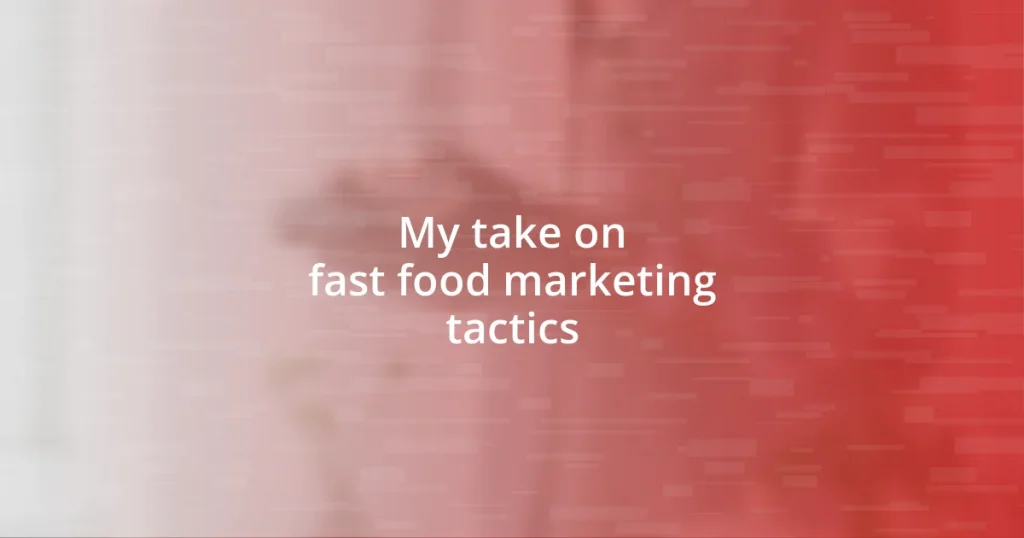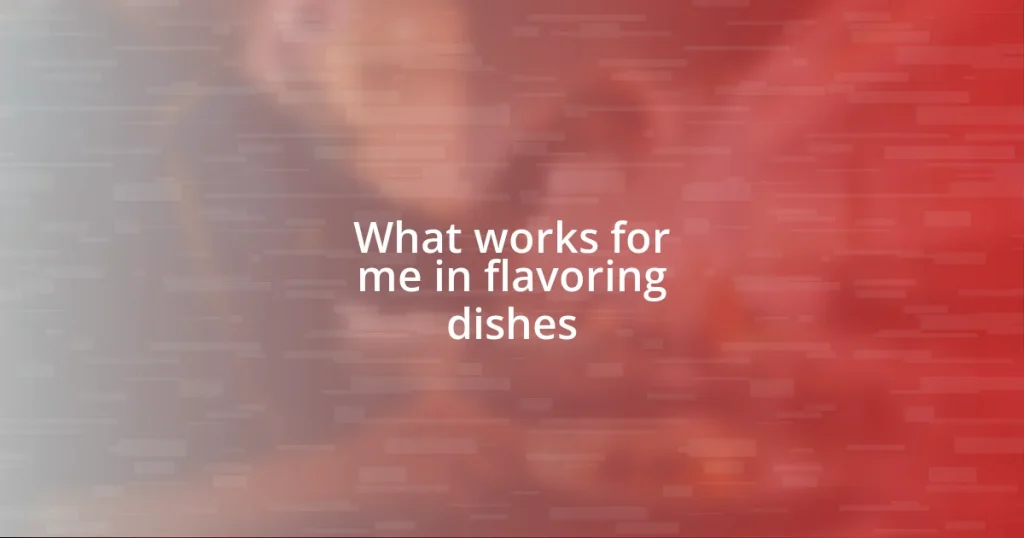Key takeaways:
- Fast food marketing leverages psychological tactics like FOMO, emotional imagery, and loyalty programs to drive consumer engagement and impulsive purchasing.
- Brands strategically target different demographics (families, young adults, and late-night crowds) to tailor menus and marketing strategies that resonate with their specific preferences.
- Social media and influencer partnerships significantly enhance brand visibility and trust, influencing consumer choices through authentic experiences and community engagement.

Understanding fast food marketing tactics
Fast food marketing tactics are a fascinating blend of psychology and strategy. For instance, when I recall those vibrant ads showing mouthwatering burgers, I realize they evoke an emotional response that drives cravings. Have you ever found yourself daydreaming about that crispy fry or juicy sandwich after seeing a flashy commercial? It’s no wonder these brands invest heavily in creating such appetizing imagery.
One tactic that stands out is the use of limited-time offers. I remember feeling an unexpected rush when I spotted a sign for a special burger. Those fleeting promotions create a sense of urgency that compels me to act quickly, often pushing me to make impulsive decisions. This “fear of missing out,” or FOMO, is expertly leveraged by brands to boost sales and capture attention.
Additionally, loyalty programs play a crucial role in engaging customers. When I signed up for a rewards app from my favorite fast-food chain, I felt an instant connection. Every time I collected points, it was like I was part of a club—an insider enjoying exclusive benefits. This sense of belonging can significantly influence consumer loyalty, turning casual visitors into regular patrons. How powerful is that?

Targeting demographics in fast food
Fast food brands strategically target demographics to maximize their appeal and reach. For instance, I’ve noticed that chains often cater to families by offering value meals and kid-friendly menus. I remember taking my kids to a popular fast food outlet, primarily drawn there by the colorful play areas and promotional toys. This decision wasn’t just about the food; it was about creating an experience that resonated with both the children and parents, allowing the brand to capture that specific family demographic.
On the other hand, young adults and millennials are often swayed by trendy and health-conscious options. I can’t help but think back to when a well-known chain introduced a line of gourmet sandwiches and salads. It felt like they were speaking directly to me and my friends, who prioritize quality and uniqueness over simplicity. By understanding their audience, brands can modify their offerings to match the evolving tastes and preferences of different age groups, ensuring they remain relevant in a competitive market.
Conversely, the late-night crowd is a demographic that fast food outlets don’t overlook. There’s a certain nostalgia I feel thinking about those nights when my friends and I would hit the drive-thru after a concert. Fast food brands know how to market to this group by emphasizing convenience and indulgence, enticing late-night eaters with promotions and limited-time snacks. It’s fascinating how these targeted efforts shape consumer behavior and influence where we choose to grab a bite.
| Demographic | Marketing Tactics |
|---|---|
| Families | Value meals, play areas, promotional toys |
| Young Adults | Health-conscious menus, trendy options |
| Late Night Crowd | Convenience, indulgent offers |

The role of social media
Social media is a game-changer for fast food marketing, transforming how brands connect with consumers. I often find myself scrolling through platforms like Instagram, where captivating food photos seem to leap off the screen. This visual focus not only whets my appetite but also encourages immediate interaction, whether it’s liking a post or hastily commenting about how much I’d love to try that burger. The ability to create a dialogue with customers enhances brand loyalty and fosters a community around shared culinary experiences.
Here are a few key ways social media enhances fast food marketing:
- Visual Appeal: Eye-catching images create a desire for the product.
- Engagement: Brands leverage hashtags and challenges, encouraging user-generated content.
- Real-Time Interaction: Instant feedback allows brands to respond to consumer preferences and trends quickly.
- Influencer Partnerships: Collaborations with popular influencers amplify brand reach and credibility.
- Special Promotions: Limited-time offers and exclusive social media deals drive urgency and engagement.
When I see a fast food brand partner with a popular influencer, I can’t help but feel intrigued, as if my friends are endorsing a new culinary adventure. It’s this constant connection and interaction that makes social media not just an outlet for advertising but a vital part of our dining decisions today.

Influencer partnerships in marketing
Influencer partnerships in fast food marketing have become a cornerstone of how brands engage with consumers today. I’ll never forget the time I stumbled across a TikTok video of my favorite food influencer trying out a limited-edition burger from a popular chain. The way they described the flavors made my mouth water. It sparked an immediate craving that took me straight to the drive-thru. Could there be a more powerful reminder of the impact influencers have on our food choices?
What’s particularly striking is how influencers can translate their personal experiences into something relatable. When they share a story about enjoying a fast food meal after a long day, it resonates deeply with many of us. I remember a time when I was feeling particularly overwhelmed, and I saw a post from an influencer about how their comfort food was a specific chain’s crispy fries. That genuine moment of connection prompted me to treat myself to those very fries. It really made me think about how emotional experiences can drive our cravings.
These partnerships not only boost brand visibility but also establish a sense of trust among consumers. I often find myself pondering: why do we trust influencers more than traditional advertising? Perhaps it’s because they share their authentic experiences, which feels much more genuine. This trust can translate into sales, especially if followers see their favorite personalities enjoying a meal from a fast food joint. That personal touch makes a significant difference in how we perceive those brands and what we choose to eat.

Effective promotions and discounts
When it comes to promotions and discounts, I often think about how the urgency created by limited-time offers really pulls me in. For instance, I vividly remember a time when a popular fast food chain announced a surprise deal on their beloved breakfast combo. I hesitated for just a moment, but the countdown clock on their website pushed me to act quickly. Isn’t it fascinating how that ticking clock can make us feel like we might miss out on something special if we don’t hurry?
I also enjoy how creative discounts tend to generate excitement. A buy-one-get-one-free deal or a reward program makes me feel like I’m getting something extra. Just the other day, I found myself tempted into a restaurant because they offered double points for any purchase during lunchtime. The thought of treating myself while earning rewards felt incredibly satisfying. It’s as if those brands know precisely how to tap into our desire to save while splurging a little.
Regular promotions appeal to my sense of nostalgia, too. I often think back to childhood days of Happy Meal toys or the thrill of a dollar menu. Those memories influence my loyalty to certain brands. I wonder: how many others feel the same pull from those nostalgic promotions? It’s incredible how effective discounts can be in evoking emotions that drive our choices time and again.

Evaluating the impact of campaigns
Evaluating the impact of marketing campaigns in the fast food industry can be quite revealing. I recall a time when a major chain launched a campaign centered around sustainability, highlighting their efforts to reduce waste. Watching their engaging ads prompted me to rethink how my consumption habits align with my values. This emotional connection made me more inclined to choose their brand over others – isn’t that a powerful testament to effective marketing?
Analyzing specific metrics is essential for understanding campaign success. For instance, I remember when a local restaurant introduced a social media challenge and saw a surge in engagement. The number of shares and user-generated content skyrocketed, demonstrating the campaign’s ability to foster community and connection. It really made me wonder: how often do brands overlook these metrics in favor of just flashy ads?
There’s also something to be said about consumer feedback and sentiment. After a fast food chain revamped its menu and sought customer opinions, I was intrigued by the response they received. The genuine conversations sparked by this initiative created an authentic dialogue between the brand and consumers. I found myself more invested in their offerings, reinforcing the power of listening to your audience. Don’t you think that real engagement is what truly shapes brand loyalty?















